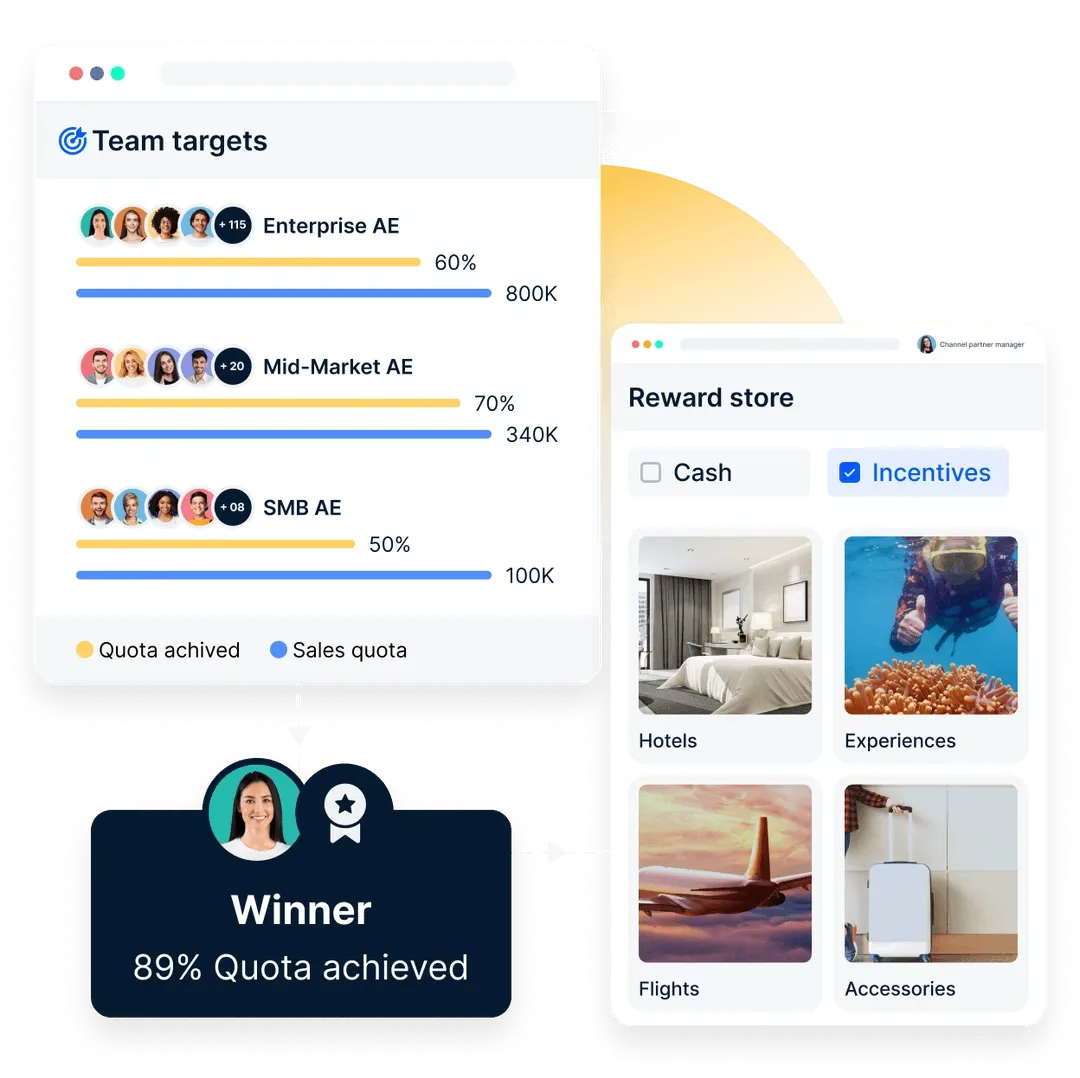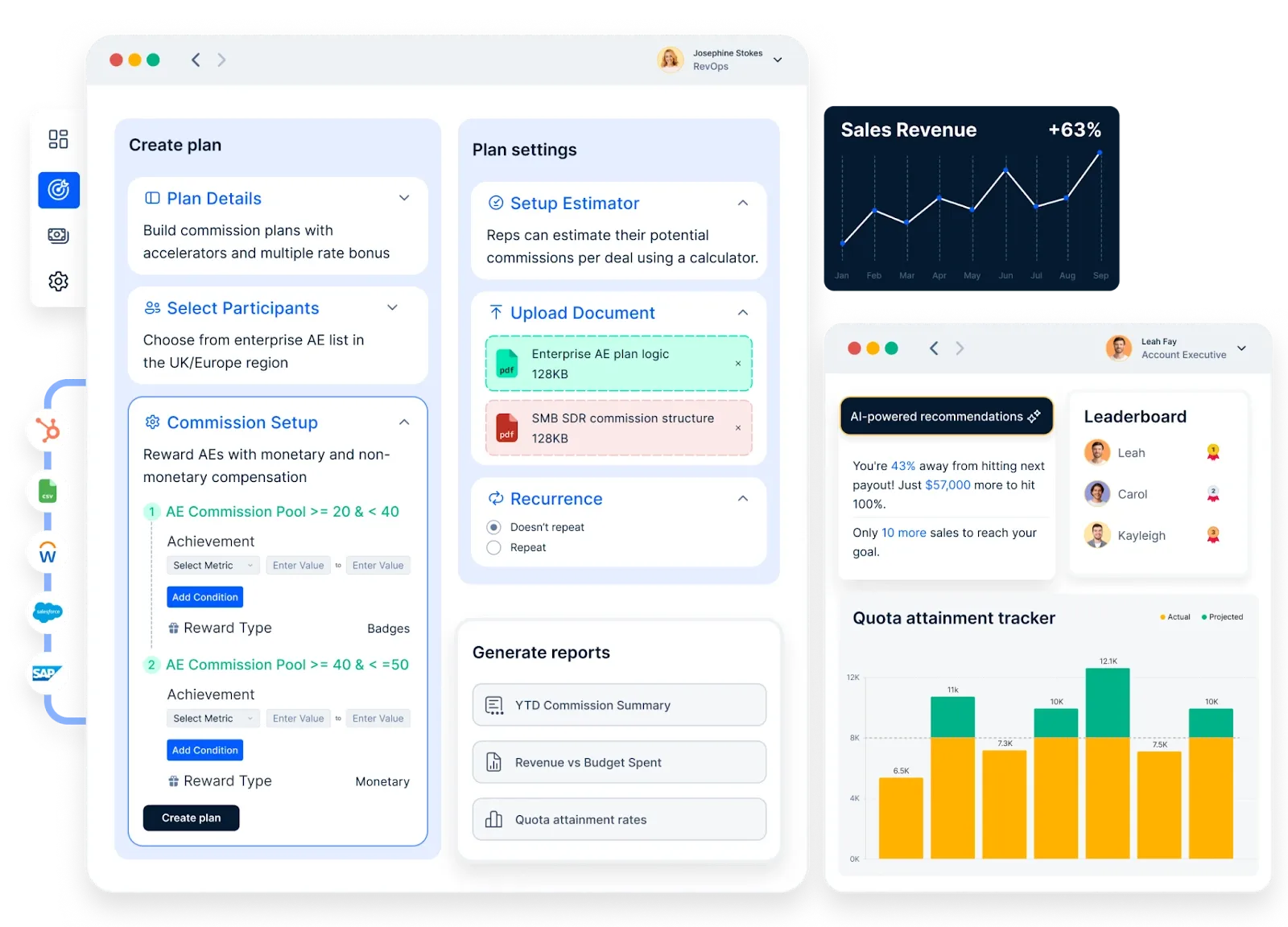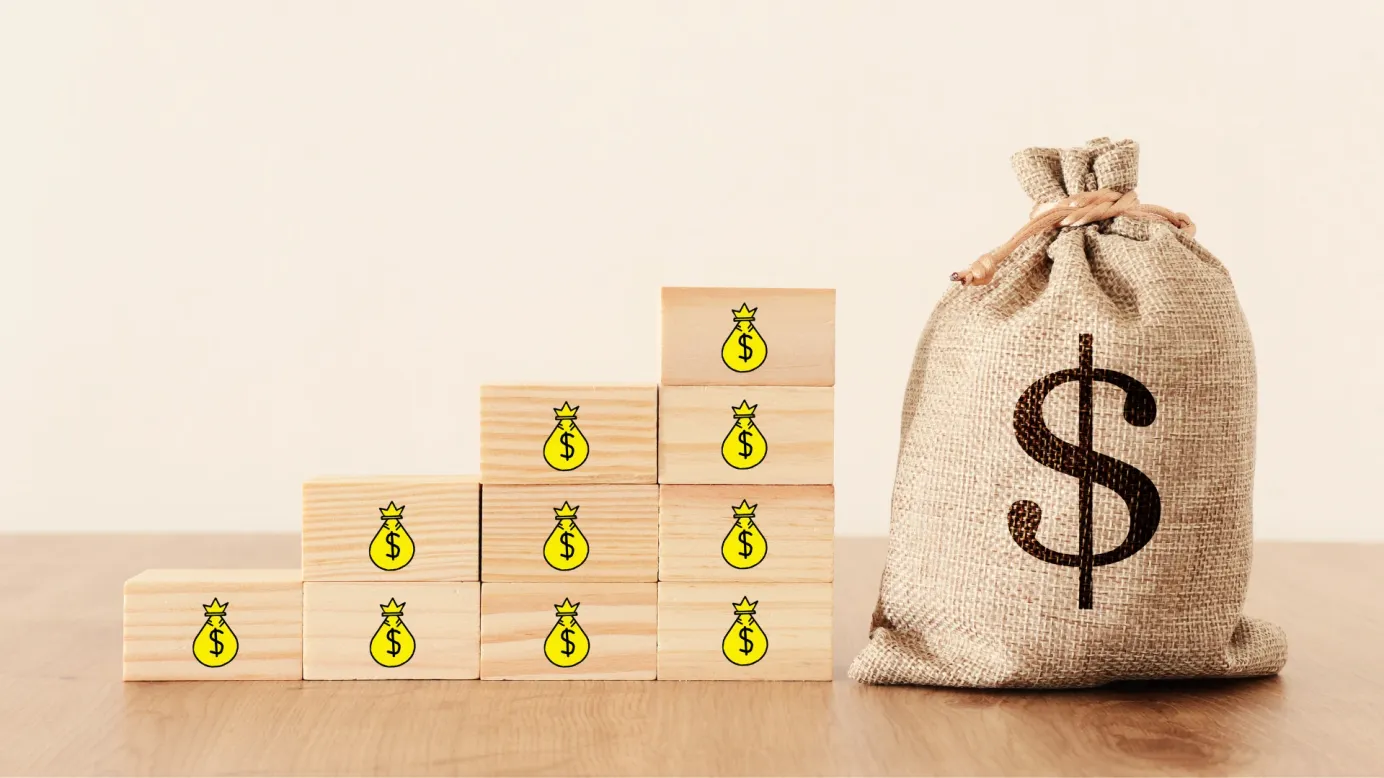How to Create a Sales Incentive Program: A Comprehensive Guide
How to create a sales incentive program that truly motivates? It’s about more than just bonuses. A well-structured incentive plan drives performance, keeps teams engaged, and aligns rewards with business goals. This guide covers essential steps to design a program that delivers real results
On this page
Companies constantly seek ways to boost sales and motivate their sales teams. One effective strategy is to implement a well-designed sales incentive program.
Sales incentive programs are essential for organizations looking to motivate their sales teams, drive performance, and achieve business goals. These programs are designed to provide incentives and rewards to sales professionals based on their performance, ultimately boosting sales and revenue.
A sales incentive program can increase sales and enhance employee engagement and productivity by providing tangible rewards and recognition for outstanding performance.
According to a study by the Incentive Research Foundation (IRF), companies that implemented sales incentive programs experienced an average revenue increase of 27%.
In this article, we will explore the key steps involved in creating a successful sales incentive program.
What are sales incentive programs?
A sales incentive program is a structured system that rewards and recognizes salespeople for meeting or exceeding specific targets, such as sales quotas, revenue goals, or customer acquisition metrics. These programs aim to create a competitive and results-driven environment within the sales team.
Sales incentive programs are crucial for several reasons. First, they provide a clear framework for defining and rewarding desired behaviors and outcomes. Organizations can steer their sales team toward activities that drive growth and profitability by aligning incentives with business objectives.
Second, sales incentive programs enhance motivation and morale among sales professionals. The prospect of earning rewards and recognition encourages individuals to go above and beyond, resulting in increased effort and performance.
According to a survey conducted by WorldatWork, 75% of organizations consider sales incentive programs as a crucial tool for driving desired sales behaviors and outcomes.
Benefits of implementing sales incentive programs
Implementing a well-designed sales incentive program offers numerous benefits to organizations. It drives sales performance, fosters a positive sales culture, and improves overall team dynamics.
- Increased sales and revenue: Motivating salespeople to achieve their targets, sales incentive programs directly contribute to increased sales and revenue generation for the organization.
- Improved team morale and motivation: Incentives create a sense of excitement and healthy competition among sales team members, boosting morale and motivation to excel in their roles.
- Enhanced focus on key objectives: Sales incentive programs help align the sales team's efforts with the organization's key objectives, ensuring that everyone is working towards shared goals.
- Talent attraction and retention: Well-structured incentive programs can attract top sales talent to join the organization and retain high-performing sales professionals in the long run.
Data collection and analysis: Sales incentive programs often involve tracking and analyzing performance data, providing valuable insights for strategic decision-making and continuous improvement.

Automate commission payouts and align rewards with sales goals. With Compass, you can motivate your team and improve overall sales effectiveness. Automate Incentives Now
Types of sales incentive programs
Here are different types of sales incentive programs.
1. Cohort-based incentive programs
In the Cohort base incentive programs, users are classified on the basis of several cohorts like top performers, middle performers, and tail-end performers.
Typically 5-10% of users are top performers, 25-30% are middle performers, and the rest 60-70% are tail-end performers. It's important to look at these users differently because they come with different mindsets, calibers, and approaches.
Setting up a Cohort-based incentive program:
- Step 1: The first step is to map the performance cohorts for your organization/ team. Identify and categorize the top 10%, the middle 30%, and the last 60% of your team members. Qualify every member into one of these categories.
- Step 2: The objective of the cohort-based incentive program is to motivate and bring up the average performance of the cohort. For doing this, you need to identify the average and maximum performance of the cohort. If the program needs to have a business impact, it needs to push performances to above the average performance of the cohort.
- Step 3: Go on to create milestones between the group average and 105% to 120% of the group maximum (for the top performers of the cohort to be motivated with the program).
- Step 4: Offer preferably incremental or even fixed incentives for every milestone.
Cohort: Top 10%
Cohort Name: Super Stars
Average Revenue of last quarter: $ 10000
Maximum Revenue of last quarter: $ 12000
Reward type and value: Fixed incentive of 2.5% of the revenue. Slightly incremental for the last slab.
Incentive Structure
Slab 1: Achieve revenue of $10000 to 10500, Get $250 rewards
Slab 2: Achieve revenue of $10501 to 11000, Get $262 rewards
Slab 3: Achieve revenue of $11001 to 11500, Get $275 rewards
Slab 4: Achieve revenue of $11501 to 12000, Get $287 rewards
Slab 5: Achieve revenue of $12001 to 12500, Get $300 rewards
Slab 6: Achieve revenue of >12500, Get $320 rewards
Similarly, the slabs can be set up for the rest of the cohorts by maintaining the reward value within the permissible limits of the business.
2. Role-Specific Incentive Programs
Sales teams consist of individuals with different responsibilities, and a one-size-fits-all incentive program may not be effective. Role-specific incentive programs ensure that sales representatives, account executives, and business development reps are rewarded based on their unique contributions.
Setting up a role-specific incentive program:
- Step 1: Identify the different sales roles within your team and define their key objectives.
- Step 2: Set performance benchmarks that align with each role’s contribution to the sales process. For example, Sales Development Representatives (SDRs) can be incentivized for booking qualified meetings, while Account Executives (AEs) can be rewarded for closing deals.
- Step 3: Structure rewards based on the complexity of the task. For instance, SDRs could receive a fixed bonus per meeting scheduled, while AEs earn commission-based incentives for exceeding quotas.
- Step 4: Continuously review performance data to ensure the incentive structure remains relevant and effective.
End Goal: Increase qualified sales meetings.
Program Name: SDR Performance Booster
KPIs: Number of meetings booked, number of sales-qualified leads.
Reward type and value: Fixed incentive for each completed meeting, with incremental bonuses for exceeding targets.
Incentive Structure:
Slab 1: Schedule 5-7 meetings → $50 bonus
Slab 2: Schedule 8-10 meetings → $75 bonus
Slab 3: Schedule 11+ meetings → $100 bonus
3. Split Sales Incentive Programs
Sales deals often involve multiple team members, from lead generation to closing. A split sales incentive program ensures that all contributors are fairly rewarded, fostering teamwork and collaboration instead of individual competition.
Setting up a split sales incentive program:
- Step 1: Identify roles that contribute to closing a deal, such as SDRs, Account Executives, and Sales Engineers.
- Step 2: Define contribution levels for each role to determine how incentives should be distributed.
- Step 3: Set percentage-based or fixed incentive splits to ensure fair payouts. For example, an SDR who generated the lead may receive 10% of the commission, while the AE closing the deal gets 70%, and the Sales Engineer assisting in technical discussions gets 20%.
- Step 4: Automate tracking and reward distribution to avoid disputes and ensure transparency.
End Goal: Encourage teamwork in closing deals.
Program Name: Team Success Bonus
KPIs: Closed deals, contribution percentage per role.
Reward type and value: Percentage-based commission split among contributors.
Incentive Structure:
SDR (Lead Generation): 10% of commission per deal
Account Executive (Deal Closure): 70% of commission per deal
Sales Engineer (Technical Support): 20% of commission per deal
4. KPI & micro-KPI linked incentive programs
Typically incentives are given based on final sales output. However, to influence the final output intermediate outputs need to be incentivized too.
For example, demos lead to opportunities and opportunities lead to Sales. Here are more demos a salesman gives, more opportunities he will generate, and more closures to happen. Hence micro-incentivizing people based on Demos and Opportunities influences sales behavior.
Setting up a KPI-based incentive program:
- Step 1: The first step is to identify the KPIs relevant to the target team members
- Step 2: The objective of the KPI-based incentive program is to push team members to complete micro-KPIs that help achieve the End goal. For doing this, you need to individually identify the average and maximum of every Micro-KPIs of the team during the past quarter/period. Your overall target for a KPI needs to be between this average and the maximum achievement. Ideally, this should be at the 2σ mark if your team’s previous performances on each of the Micro-KPIs are plotted on a normal curve.
- Step 3: Go on to create milestones sequentially for every Micro-KPI
- Step 4: Offer incremental or fixed incentives for every milestone.
End goal: Sales closure
Program name: Super Closers
Micro KPIs: Number of Demos, Number of Project scope document completed, Number of Sale Agreements signed, Number of Sales closed
Reward type and value: Variable and Incremental incentive
5. Badge-based incentive programs
It's important to appreciate users' basis of their achievements and behaviors with non-monetary rewards. Badges and certificates can be used to motivate people- particularly to include and motivate performance at the starting end of the target achievement.
Setting up a Badge based incentive program:
- Step 1: The first step is to identify the badges based on milestones of the program
- Step 2: The objective of the badge/certificate-based incentive program is to push team members to complete the distance between the start of the month and the first rewarding milestone.
- Step 3: Go on to create milestones for every step identified.
- Step 4: Set up and offer badges for every milestone identified
End goal: Push users till 80% of target achievement
Program name: Badge rush
Milestones: 20% of Target achievement, 40% of Target achievement, 60% of Target achievement, 80% of Target achievement
Reward Structure
Slab 1: Achieve 20% of Target achievement win ‘Quick starter’ Badge
Slab 2: Achieve 40% of Target achievement win ‘Milestone crusher’ Badge
Slab 3: Achieve 60% of Target achievement win ‘Blockbuster’ Badge Slab 4: Achieve 80% of Target achievement win ‘Badge ranger’ Badge

Gamify Sales Performance for Higher Engagement
Turn sales goals into exciting challenges with leaderboards, rewards, and real-time tracking. Compass makes performance management engaging and competitive.
Start Gamifying Sales
6. Hierarchy-based incentive program
Sales usually have a regional sales team that reports to a zone-head and then Geo-head and then a national-head. It's important to roll out incentive programs across all levels of the hierarchy. This keeps each of the levels motivated at all times.
A typical hierarchy-based program could either be a KPI-based or cohort-based program mapped for every hierarchy individually - with its own targets.
7. Behavior-based incentive programs
Different types of sales teams face different behavioral barriers. Some may face fatigue for improvement, or certain sales ratios aren't improving (like Demo: Closures, Cross-sales, Upsells, etc). Incentive programs can be configured to improve these ratios.
Setting up a behavior-based incentive program:
- Step 1: The first step is to identify the behaviors/ business ratios that result from these behaviors
- Step 2: The objective of the behavior-based incentive program is to push team members to break through their stagnant performance ratios. Similar to the micro KPI programs, identify a range of values between the 2 sigmas and 3 sigmas of each of these ratios in your team.
- Step 3: Go on to create milestones that check for fulfillment of each of these ratio limits identified.
- Step 4: Offer fixed/ incremental rewards for every milestone
End goal: Push users to participate in cross-selling and upselling
Program name: Sales allrounder
8. CRM-utility-based incentive programs
It's been a fact that 70% CRMs fail to convince sales teams to their full adoption. Sales teams are reluctant to change and use a CRM.
Communicating 100% dependency on incentives on the sales team's CRM feed and creating an incentive program that pulls data from only the CRM increases its usage/adoption radically.
9. Seasonal or time-based incentive programs
Businesses may have seasonality during the month or during the year. To evenly spread the business volumes - Time-based incentive programs are launched.
Seasonal incentive programs are also rolled-out during business spike season. This makes users go the extra mile when the market is the most potential.
10. PIP (Performance improvement programs)
There are users who either are not competent or are not willing to deliver/sell. It's important to churn those users objectively. PIP programs (or next 30-day plans) are configured based on the past performance of users. The output of which is considered for retention.
Setting up a PIP incentive program:
- Step 1: The first step is to identify the KPIs that the user needs to complete in the next 30 days to be allowed to be retained.
- Step 2: The objective of the PIP program is to help retail team members and develop them to become better performers. You need to identify the lower rung of performances of KPIs of the rest of the team during the past period. The target for the PIP KPIs need to be set as this minimum performance. Split these targets into 4 intermediary targets (typically one for each week)
- Step 3: Go on to create milestones for every group of PIP KPIs
- Step 4: Offer badges at every milestone and if the budget allows a reward.
End goal: Performance improvement
Program name: Rising Star
PIPs KPIs: LMS module completion, PIP Target achievement
11. Team-based incentive programs
In order to bring a sense of togetherness as a team - team-based incentive programs are launched. These incentive programs are typically geographical or managerial-led.
A typical team based program could be a KPI based program with overall team targets broken into milestones.
12. Beat-the-champion incentive programs
To give a mega-boost to users - Beat-The-Champion of last month/quarter/year is launched. This influences users (especially middle and lower level performers) to get a self-push to achieve more and beat the champion.
Setting up a beat-the-champion incentive program:
- Step 1: The first step is to identify the list of champions (first 4 rank holders) and their respective ranks
- Step 2: The objective of the Beat-The-Champion program is to help users beat the target achievements of these champions.
- Step 3: Go on to create milestones for target achievements of each of the rank holders.
- Step 4: Offer rewards at every milestone.
End goal: Performance improvement
Program name: Beat the Champion
13. Personalized goal-setting incentive programs
Not all sales reps are motivated by the same targets. A personalized goal-setting incentive program allows individuals to choose their targets and rewards, increasing motivation and commitment to achieving results.
Setting up a personalized goal-setting incentive program:
- Step 1: Allow sales reps to select their own sales goals from a predefined set of options. This could include revenue targets, deal volume, customer acquisition, or upsell percentages.
- Step 2: Assign varying reward structures based on goal difficulty. Higher-risk goals with bigger challenges should come with higher rewards.
- Step 3: Provide ongoing performance tracking, allowing reps to adjust their targets mid-cycle if needed.
- Step 4: Celebrate individual achievements through public recognition, badges, and leaderboard rankings to encourage healthy competition.
End Goal: Give sales reps ownership over their targets.
Program Name: Choose Your Challenge
KPIs: Individualized sales goals (quota, deal size, customer retention, or upselling).
Reward type and value: Customized incentives based on goal difficulty.
Incentive Structure:
Goal 1: Close 5 new deals → $500 bonus
Goal 2: Close 3 enterprise deals → $800 bonus
Goal 3: Increase upsell revenue by 20% → $1,000 bonus
14. Experiential reward programs
Monetary incentives aren’t the only way to drive motivation. Experiential reward programs focus on offering unique, memorable experiences—such as travel, VIP events, or exclusive access—to inspire peak performance. These rewards create lasting value beyond cash incentives.
Setting up an experiential reward program:
- Step 1: Identify experience-based rewards that resonate with your sales team, such as luxury travel, concert tickets, or exclusive networking events.
- Step 2: Set performance targets that align with these high-value rewards, ensuring that top performers receive experiences that match their effort and results.
- Step 3: Create tiered achievement levels where sales reps can unlock better experiences as they surpass milestones.
- Step 4: Publicly recognize winners and share their success stories to inspire others.
End Goal: Reward top performers with exclusive experiences.
Program Name: Elite Achievers Club
KPIs: Revenue growth, deal size, quota overachievement.
Reward type and value: Experience-based rewards instead of monetary bonuses.
Incentive Structure:
Slab 1: Achieve 100-110% of quota → All-expenses-paid luxury dinner
Slab 2: Achieve 111-120% of quota → Weekend getaway at a premium resort
Slab 3: Achieve 121%+ of quota → International vacation or VIP event access
How to create a sales incentive program
A well-designed sales incentive program does more than reward performance—it drives behavior, aligns sales efforts with business goals, and fosters long-term engagement. Here’s how to create a structured and effective sales incentive program using Compass.
1. Define clear objectives
A sales incentive program needs a strong foundation, starting with clearly defined objectives. Are you looking to increase deal closures, shorten sales cycles, or drive expansion into new markets? Without a clear direction, even the most attractive incentives may fail to deliver results.
Compass ensures that your incentive program aligns with broader business priorities by providing AI-driven insights into sales performance. It tracks individual and team contributions, helping you measure progress against goals in real time. With visibility into key metrics, you can refine strategies and adjust rewards based on actual sales outcomes.
2. Identify key performance indicators (KPIs)
The success of a sales incentive program depends on choosing the right performance metrics. Clear and measurable Key Performance Indicators (KPIs) ensure that sales reps understand what they need to achieve and how their efforts contribute to overall business growth.
Common KPIs for sales incentive programs include:
- Total revenue generated: Encourages overall sales growth.
- New customer acquisition: Drives efforts toward expanding the client base.
- Deal size and value: Incentivizes high-value sales rather than just volume.
- Upsell and cross-sell rates: Motivates reps to maximize revenue per customer.
- Sales cycle length: Rewards efficiency in closing deals faster.
- Customer retention and renewals: Encourages long-term relationship building.
- Lead conversion rates: Focuses on improving sales pipeline efficiency.
Compass automates KPI tracking with real-time analytics and reporting. Sales reps get instant feedback on their performance, while managers gain actionable insights to fine-tune strategies. AI-driven recommendations help identify which KPIs drive the most impact, allowing for continuous program optimization.
3. Design the incentive structure
An effective incentive program goes beyond offering rewards—it must be structured to drive the right behaviors while keeping sales teams engaged. The key is to strike a balance between monetary and non-monetary incentives to appeal to different motivations.
Types of sales incentives to consider:
- Monetary rewards: Commissions, bonuses, profit-sharing, or tiered incentives based on performance.
- Non-monetary rewards: Recognition programs, career advancement opportunities, and VIP experiences.
- SPIFs (sales performance incentive funds): Short-term rewards to boost performance in specific areas, such as closing deals faster or selling high-margin products.
- Team-based incentives: Encourages collaboration by rewarding groups for achieving shared targets.
- Milestone-based rewards: Recognizes consistent performance over time rather than just one-time achievements.
Compass allows businesses to customize their incentive structures based on real-time sales data. With automated commission calculations, dynamic goal-setting, and gamification features, Compass keeps sales reps motivated while ensuring fairness and transparency in payouts. The platform also enables A/B testing of different incentive structures, so you can refine your approach based on what drives the best results.
4. Communicate the program effectively
Even the best-designed sales incentive program can fall flat if it's not communicated clearly. Sales reps need to understand how the program works, what they need to do to earn rewards, and how their performance will be tracked. Confusion or lack of transparency can lead to disengagement, reducing the program’s effectiveness.
Key elements of effective communication:
- Clarity on goals and rewards– Clearly define what behaviors and achievements will be rewarded.
- Multiple communication channels: Use emails, team meetings, dashboards, and one-on-one sessions to ensure everyone is informed.
- Real-time visibility: Allow reps to track their earnings, progress toward targets, and leaderboard standings at any time.
- Regular updates and reminders: Reinforce engagement with periodic updates on performance standings and upcoming opportunities.
Compass simplifies program communication with a centralized dashboard where sales teams can track their progress in real time. Personalized notifications and AI-driven nudges keep reps engaged and focused on hitting their targets. Leaderboards and automated performance updates ensure everyone knows where they stand, driving friendly competition and higher participation rates.
5. Implement the program with the right tools
A well-designed sales incentive program needs seamless execution. Simply announcing incentives isn’t enough—sales reps must have the tools and resources to perform at their best. The implementation phase should focus on equipping the team with everything they need to succeed, from training materials to ongoing support.
Key steps for smooth implementation:
- Provide access to training and sales resources: Ensure sales reps have updated collateral, pitch decks, and product knowledge to close deals effectively.
- Integrate with sales processes: The incentive program should align with existing workflows, making it easy for reps to participate without disrupting their daily activities.
- Offer real-time support: Provide managers with insights into sales performance so they can coach reps and address challenges as they arise.
- Ensure immediate performance tracking: Sales reps should have instant visibility into their achievements, pending rewards, and targets.
Compass streamlines implementation by integrating incentive programs directly into the sales workflow. With real-time tracking, automated commission calculations, and AI-powered coaching, sales teams stay focused and motivated. Personalized dashboards allow reps to see their progress, access resources, and receive timely nudges to help them stay on track.
6. Monitor and adjust the program
A sales incentive program is not a "set-it-and-forget-it" initiative. Regular monitoring is essential to ensure that the program continues to drive the right behaviors and adapts to evolving business needs. Without ongoing analysis, incentive structures can become outdated, leading to disengagement or unintended consequences.
Key aspects of effective program monitoring:
- Track performance trends: Identify which incentives are driving the highest impact and where adjustments are needed.
- Collect sales rep feedback: Gain insights from participants to understand what’s working and what needs improvement.
- Analyze incentive ROI: Compare investment in rewards with revenue growth, deal size, and overall sales productivity.
- Adjust incentive structures when necessary: Modify targets, payout structures, or reward types to keep the program relevant and effective.
Compass simplifies program monitoring with AI-powered analytics that provide real-time insights into sales performance. The platform automatically identifies trends, flags underperforming areas, and recommends optimizations to maximize incentive effectiveness. With Compass, you can continuously refine your program to ensure long-term engagement and business growth.
7. Measure the program’s success
To determine whether your sales incentive program is achieving its intended goals, you need a structured approach to measuring success. Simply looking at revenue growth isn’t enough—you need to evaluate how incentives influence sales behavior, team engagement, and long-term business performance.
Key ways to measure success:
- Compare sales data before and after implementation: Assess improvements in key metrics such as revenue growth, deal size, and conversion rates.
- Evaluate KPI achievement rates: Track how many sales reps are meeting or exceeding their targets.
- Monitor retention and engagement: High-performing sales reps staying with the company longer is a strong indicator of an effective incentive program.
- Assess team productivity: Determine whether sales cycles have shortened and if reps are closing more deals efficiently.
- Gather direct feedback: Conduct surveys or hold discussions with your sales team to identify strengths and areas for improvement.
Compass provides in-depth performance tracking and analytics to measure the effectiveness of your incentive program. AI-driven insights help you understand which incentives are working, which need adjustments, and how the program contributes to overall business growth. With Compass, sales leaders can make data-backed decisions to refine their strategy and continuously improve results.
8. Overcome common challenges
Even the best-designed sales incentive programs can face obstacles. Misaligned goals, lack of engagement, or unclear reward structures can reduce effectiveness. Addressing these challenges early ensures that your program remains impactful and drives consistent sales performance.
Common challenges and solutions:
- Unclear incentive structures: If sales reps don’t fully understand how they’re rewarded, engagement drops. Compass provides real-time dashboards that display earnings, progress, and goals transparently.
- Low participation rates: Some reps may not feel motivated by traditional incentives. Gamification features in Compass, such as leaderboards, achievement badges, and personalized nudges, keep engagement high.
- Lack of Adaptability: Market conditions change, and static incentive programs quickly become ineffective. Compass uses AI-powered insights to suggest program adjustments, ensuring incentives remain relevant.
Delayed payouts and tracking issues: Manually calculating commissions can lead to errors and disputes. Compass automates commission calculations, eliminating delays and ensuring accurate, transparent payouts.
Sample sales incentive plan structure
Program Name: Q2 Sales Performance Incentive Plan
Objective: Increase overall revenue by 20% and improve customer acquisition through targeted sales efforts.
Eligibility: All sales representatives and account managers
Duration: April 1 – June 30
Incentive types
Monetary incentives:
- 5% commission on all closed deals
- $1,000 bonus for exceeding quarterly sales targets by 15%
Non-monetary incentives:
- "Top Performer of the Quarter" award with a $500 gift card
- Exclusive sales training and mentorship for top 3 performers
Team-based incentives:
- If the entire sales team reaches the 20% revenue growth target, each member gets a weekend retreat package
Performance metrics & rewards
Payout structure
Flat-rate commission: 5% commission on all sales
Tiered commission: 7% commission for sales exceeding $75,000 in a quarter
Bonus thresholds: $1,000 bonus for 10+ new customers
Communication & tracking
- Communication plan: Weekly team meetings, performance dashboards, and email updates
- Tracking tools: Salesforce CRM, real-time sales leaderboard
Review & adjustments
- Evaluation frequency: Mid-quarter and end-of-quarter reviews
- Feedback mechanism: Monthly surveys to assess program effectiveness
This sales incentive program is designed to drive motivation, increase revenue, and reward high performers while ensuring sustainable growth.
Power up your sales incentives with Compass

Compass makes sales incentives seamless with automated commissions, real-time leaderboards, and AI-driven insights. Motivate your team with transparent payouts, gamified challenges, and data-backed rewards that drive performance.
Build a winning incentive program today!
Conclusion
A well-designed sales incentive program can be a powerful tool for increasing sales, enhancing employee engagement, and boosting productivity.
By following these key steps, you can create a program that aligns with your business goals and drives the desired behaviours from your sales team. Remember to continuously monitor and adjust the program based on data and feedback, and celebrate your team's successes.
FAQs
Here are some frequently asked questions about sales incentive programs.
What types of incentives are most effective for sales teams?
The most effective incentives for sales teams include monetary rewards like bonuses and commissions and non-monetary rewards such as travel incentives and recognition programs.
How often should performance reviews be conducted?
Performance reviews should be conducted on a regular basis, typically quarterly or annually, to provide feedback and assess progress.
What happens if a sales team member does not meet their targets?
If a sales team member does not meet their targets, it's important to provide coaching and support to help them improve. Depending on the situation, there may be additional training or performance improvement plans.
Should incentives be given to top performers only or to all sales team members?
Incentives can be given to top performers and all sales team members, depending on the program's goals. It can motivate the entire team and recognize individual achievements.
Can a sales incentive program be integrated with other employee recognition programs?
Yes, a sales incentive program can be integrated with other employee recognition programs to create a comprehensive and inclusive rewards system that recognizes both sales achievements and other contributions to the organization.













